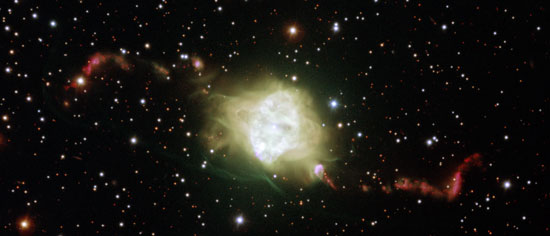| Nov 07, 2012 |
Astronomer's model helps identify binary star inside curved-jet-shooting nebula
|
|
(Nanowerk News) University of Tübingen astronomer Dr. Thomas Rauch has helped an international team of astronomers with their discovery of a pair of stars circling inside one of the strangest known planetary nebulae. The researchers used his new model to confirm a long-debated theory on the spectacular and symmetrical appearance of matter hurled into space by binary stars. The results of the study are to be published in Science magazine (09.11.2012).
|
 |
| The planetary nebula Fleming 1 with s-shaped jets (red) caused by the newly-discovered.
|
|
Planetary nebulae are glowing shells of gas surrounding white dwarfs – similar to our sun in its final phase. “Fleming 1” is a fine example of a nebula shooting out strikingly symmetrical jets of gas, which form knotted, curved patterns. The nebula is in the Centaurus constellation and was discovered just over one hundred years ago by Williamina Fleming, a former maid employed by the Harvard College Observatory when her talent for astronomy became known.
|
|
Astronomers have long debated the cause of these symmetrical jets. Now a team of researchers headed by Henri Boffin (ESO, Chile) has combined new observations from the Very Large Telescope at the European Southern Observatory in Chile with new computer modeling techniques developed by Dr. Rauch. The results gave the astronomers an explanation of how these bizarrely-shaped jets are formed. An analysis of the light coming from the heart of the nebula showed that it is most likely a close binary system of two white dwarfs revolving once in just 1.2 Earth days. Systems like that are very rare.
|
|
The new study shows that the patterns observed in the Fleming 1 nebula are the result of the inter-play between the two stars in their dying phase. It is the most comprehensive case to date of a bina-ry star system for which simulations have correctly predicted how the surrounding nebula is formed.
|
|
As the two stars aged, they spread out. Sometimes one star became a stellar vampire, sucking mat-ter from its twin. That matter was drawn towards the vampire and accreted around it in a disc. As the two stars circle each other, they cause the disc to wobble like a spinning top. That movement forces matter outward at the poles of the system – the jets. The new study appears to confirm that the wobbling disc of gaseous matter in binary star systems is the cause of the remarkably symmetrical shapes appearing around the Fleming 1 planetary nebula.
|

